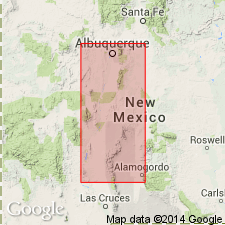
- Usage in publication:
-
- Cuchillo Negro formation
- Modifications:
-
- Named
- Dominant lithology:
-
- Limestone
- Chert
- Sandstone
- Conglomerate
- AAPG geologic province:
-
- Orogrande basin
Summary:
Name proposed for "all strata between top of Mud Springs formation below and base of Des Moines series above" [in stratigraphic table and in measured section, author shows Cuchillo Negro as overlying Hot Springs Formation of Mud Springs Group (both new), and underlying with probable unconformity Warmington Limestone Member of Elephant Butte Formation of Armendaris Group (all new), the basal part of Desmoines Series.] Name derived from Cuchillo Negro Peak, where well exposed. Type locality is section measured near north end of Mud Springs Mountains at west end of Whiskey Canyon, just west of westernmost box canyon, in SW1/4 sec 1, T13S, R5W, Sierra Co, NM in Orogrande basin. Is about 28 ft thick at type, and composed almost entirely of medium- to light-gray, massive to nodular, cherty limestone. Calcareous algae are extremely abundant in some portions of the formation and make up more than 50 percent of some strata. Two thin beds of greenish to brownish coarse-grained sandstones to granule conglomerates occur in lower portion in some areas. One of these sandstones occurs at base; other is about 15 ft above base. Fossiliferous, with brachiopods, corals, bryozoans, crinoids, and gastropods. Fusulinid Foraminifera very abundant--some index fossil fusulinids found as far north as Jemez Mountains. Is Pennsylvanian (Derry) age.
Source: GNU records (USGS DDS-6; Denver GNULEX).
For more information, please contact Nancy Stamm, Geologic Names Committee Secretary.
Asterisk (*) indicates published by U.S. Geological Survey authors.
"No current usage" (†) implies that a name has been abandoned or has fallen into disuse. Former usage and, if known, replacement name given in parentheses ( ).
Slash (/) indicates name conflicts with nomenclatural guidelines (CSN, 1933; ACSN, 1961, 1970; NACSN, 1983, 2005, 2021). May be explained within brackets ([ ]).

